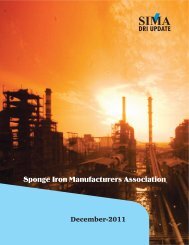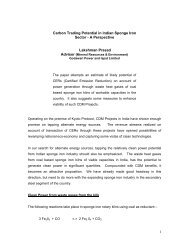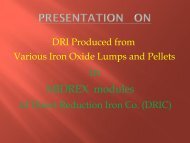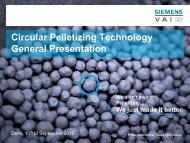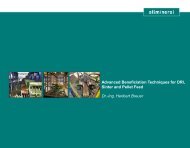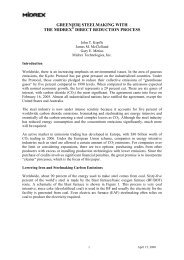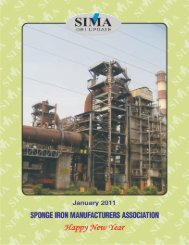You also want an ePaper? Increase the reach of your titles
YUMPU automatically turns print PDFs into web optimized ePapers that Google loves.
Power Grid:<br />
Similarly the power transmission system is to be<br />
strengthened to cater quality power as well as to<br />
facilitate evacuation of power from the captive<br />
WHRB-FBC cogeneration units.<br />
Iron Ore Requirement:<br />
Iron ore requirement, is of the order of 15 MTPA of<br />
high grade. The state has Iron ore reserved of 5671<br />
MTPA out of which high grade (Sponge grade) is<br />
2425 MT. This includes 3045 MT under captive mines<br />
1837 MT under non-captive mines and 1243 MT in<br />
virgin deposits. The state produced 54.6 % MT in<br />
2005-06 from 107 working mines. The ores were<br />
fed to domestic as well as export market. It is<br />
disappointing that the sponge industries are suffering<br />
from non-availability of Iron Ore. Besides the price<br />
escalation during the last 4 years has been hitting<br />
hard. Most of the sponge plants do not have captive<br />
mines.<br />
Coal Requirement:<br />
The coal requirement of the industries in state is<br />
about 12 MTPA of high grade, non-coking coal with<br />
ash content of 25% or less. Coal available to the<br />
plants by linkage is almost wholly of ‘F’ grade. It<br />
needs to resort to washing for which 24 MTPA coal<br />
will be required. Orissa has reserves of 62 Billion<br />
Tonne of non-coking coal largely of lower grade.<br />
Linkage have not been made for all the operating<br />
plants as yet.<br />
Development:<br />
At present kilns are operated using lower grade Iron<br />
Ore and Coal as the standard quality materials are<br />
unobtainable as well as price constraints. It has<br />
therefore become necessary to preprocess Iron Ore<br />
and Coal at plant or at customized central units. It<br />
includes low-grade ore concentration, pelletisation<br />
and washing of coal. Operation and maintenance<br />
system needs improvement for maintaining quality<br />
and output efficiency. Although the kiln operation is<br />
semi mechanized there is scope of upgrading and<br />
integrating control systems. Waste utilization, safety<br />
measures, environmental cleanliness and pollution<br />
abatement are some of the important tasks, which<br />
will continue to engage attention of the entrepreneur.<br />
Cost Impacts:<br />
Apprehensions as to economic viability and long life<br />
of the industry has been bothering the entrepreneurs<br />
in absence of assured supply of raw materials of<br />
proper quality at affordable cost. Other operational<br />
cost impacts are on account of transport, inadequate<br />
infrastructure and service facilities. In a highly<br />
competitive environment and market instability the<br />
industry is adopting higher value addition through<br />
down stream process units for conversion to steel<br />
and rolled products. Co-generation with CDM benefit<br />
is attempted to cut down the power cost besides<br />
environmental gain.<br />
Transportation:<br />
The plants are spread over 9 districts and most of<br />
them are located within 10 clusters of 20 Kms. radius<br />
each. Nearly 30% of the plants are within 25 Kms.<br />
radius of source of Iron Ore & Coal. 70% of the plants<br />
require to transport either ore or coal or both to<br />
distances of 100 to 200 Kms. As the connecting<br />
roads are presently in very bad shape, transport<br />
charges are exorbitantly high. Rail connectivity and<br />
rolling stock availability is poor for bulk movement<br />
of raw materials as well as the products. Therefore<br />
links and sidings handling system and improvement<br />
of the existing rail and road routes require to be<br />
undertaken within short span of time, if required<br />
under public, private partnership.<br />
Solid Waste Management:<br />
The solid waste generation at the sponge plants<br />
consists chiefly of coal char, which is about 15% to<br />
20%of raw feed by weight. Minor quantities of<br />
sludges are generated. The ash and dust collected<br />
from the pollution control systems and the power<br />
units need to be scientifically disposed off for which<br />
waste disposal yards are to be planned and<br />
managed. Waste recycling is also being tried.<br />
Contribution to Exchequer:<br />
The industry with its current authorized capacity has<br />
potentiality of contributing to Govt. Exchequers<br />
annually as follows:<br />
State Govt. : 651.87 Crore<br />
Central Govt. : 1678.5 Crore<br />
MOU Plants:<br />
The State Govt. has inked MOUs with 45 companies<br />
for establishing steel units in the state with capacities<br />
above 0.25 MTA. These units will have combined<br />
capacity of 81.4 MTA. Out of the above 31 plants<br />
shall be in sponge route, having total capacity of<br />
15.85 MTA Sponge Iron. These include 23 existing<br />
sponge manufacturers. Investments under these<br />
projects total Rs. 180440 Crore. Land and water<br />
requirement of the plants is 16157 Ha. and 3.3 BLD<br />
respectively. Their employment potential both direct<br />
& indirect is 28000.<br />
MAY-<strong>2007</strong>/23



